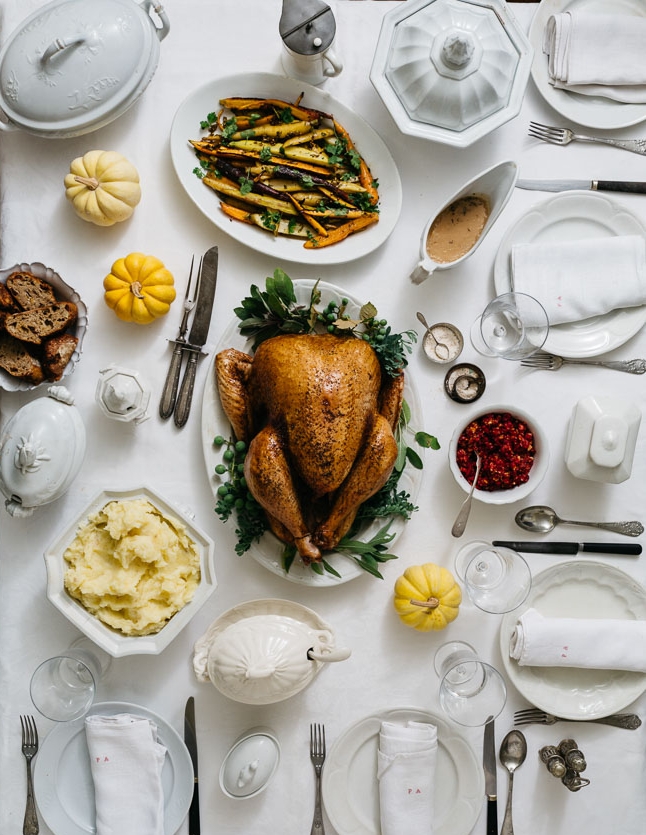The Turkey
While a uniquely American holiday, the beauty of Thanksgiving is that it still gives us plenty of room to include our own cultural traditions and tastes. Here are a few tips and suggestions from our own kitchens and our friends at Chestnut Farms:
Purchasing and Preparation
• Buy a naturally raised or heritage breed bird, either direct from a local farm or from a store with a direct relationship to a farm. Fresh birds have a 3–5 day shelf life which means they must be dressed the week of Thanksgiving.
• Smaller birds are processed in September and therefore will be frozen. That is fine. Defrost frozen birds in the refrigerator. The USDA suggests you allow about 1 day for every 5 pounds of turkey. You can defrost it quicker with a cold water bath. Submerge the bird in cold water in its airtight packaging. Allow 30 minutes per pound and change the water every 30 minutes to keep it cold.
• Remove the giblet bag and the neck from the turkey cavity. Wash the turkey inside and out and pat skin dry with paper towels.
Seasoning
• Rub the inside cavities with a handful of kosher salt. Rub the skin with kosher salt and pepper. You can either drizzle the skin with some olive oil and put the turkey straight into the oven, OR add more seasonings for an even more flavorful bird:
• If you’d like to add more flavor and fat to your turkey, carefully separate the skin from the breast with your fingers to open up the space. Rub some softened unsalted butter underneath the skin, along with fresh herbs, spices, citrus zest or slices of orange or lemon. To make a butter compound, mix your choice of seasonings or even maple syrup into softened unsalted butter.
Stuffing (or not…)
• If you like a stuffed turkey (not our favorite way to cook one, but for many it’s the only way to do it), follow the recipe for your favorite stuffing, leaving plenty of time for it to cool down. Do not fill the turkey with a hot mixture. Loosely fill both cavities and close up both ends with skewers.
• If you prefer to make your stuffing in a casserole dish and roast your bird “empty” like we do, peel and quarter a large onion, wash and cut celery and carrots into large pieces. Loosely fill both cavities with the vegetables. Root vegetables like turnips and celeriac are nice additions and can be prepared in the same manner.
Roasting
• Preheat oven to 425°F. Do not turn on the convection if you have it.
• Place turkey breast side up in a pan with 2” high sides. Pour ½ cup of liquid into the bottom of the pan (water, chicken broth, white wine, apple cider, etc.). Insert an oven-safe digital thermometer between the inner thigh and the breast. Be sure it rests in the meat and is not touching bone.
• Roast for approximately 40 minutes (or until skin is lightly browned) to sear the bird and lock in the juices.
• Lower the oven temperature to 325° and cover top of turkey loosely with tin foil.
• Roasting times for turkeys are about 20 minutes per pound stuffed and about 16 minutes per pound unstuffed. Roast until the thermometer registers 160°. The bird continues to cook after removed from the oven.
• If you don’t have a thermometer, you can tell that poultry is done when the juices run clear, without any hint of pink. Tip it until the juices run from the cavity. Another test for doneness is to wiggle the leg. The turkey is done when the legs and thighs move easily back and forth. Transfer bird to your carving board.
• If you like gravy, this is the time to make it while the bird rests.
• Let the turkey sit for at least 20 minutes to redistribute the juices. Remove the stuffing and carve.
This story appeared in the Fall 2009 issue.


